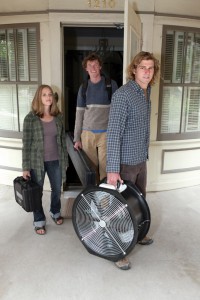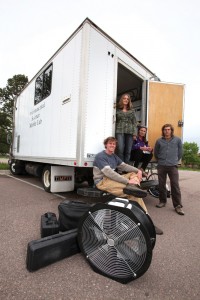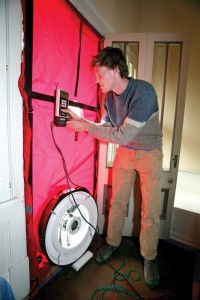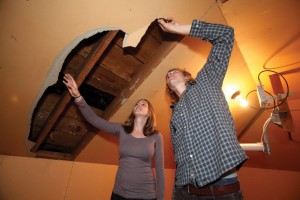Learning, Serving, and Slashing Energy Use, One Building at a Time
A student energy-auditing and retrofitting program at Colorado College is advancing sustainability one building at a time, including the home in which the new college president and her family will live.

Hoping to help make the new CC President's home more sustainable, Amanda Wierba '10, Peter Kernan '11, and Kyle Holmes '11, performed a comprehensive energy audit of the house on Wood Avenue at the request of CC facilities services. Using a computer simulation of the performance of the house and possible retrofit work, the students wrote a thorough report on how to upgrade the energy efficiency of the building. That report became the basis of such modifications as removing all baseboard heaters, replacing windows, improving insulation, and converting some drafty fireplaces to natural gas.
“The students’ recommendations are the focus of our energy management design intent,” said Chris Coulter, director of CC facilities services, about work done to improve energy efficiency at the new president’s home on Wood Avenue. “Having their input has greatly facilitated communication and the delivery of sustainability goals,” said Coulter.
In addition to working at Colorado College President Jill Tiefenthaler’s home, students also have conducted energy audits on CC’s Hulbert Center, Interdisciplinary House, and Ahlberg Gear House, as well as homes in the community.
“It’s exciting for me and for the future in terms of sustainability,” said Peter Kernan ’11 who helped assess the CC president’s home. Kernan graduated with an environmental science degree and is staying in Colorado Springs through the fall to work with the energy program. “It’s a very practical application of my education. I can see a direct impact on the environment,” said Kernan, who has been performing energy audits and making building modifications to reduce energy consumption since 2009.
“It’s very student-driven,” said Chemistry Professor Sally Meyer, who helped initiate the audit and retrofit program about 10 years ago.
She estimates approximately 325 students have participated so far, with more than 65 building audits completed since 2008 alone. The idea came about as a way to show environmental science students they can make a difference. “I noticed the environmental problems seemed so overwhelming, the students felt there was nothing they could do,” she said. Energy audits and retrofits keep students focused on solutions and the fact that each person can make decisions that have an immediate positive impact on the environment, she said.
An energy audit includes a variety of tests to judge how efficiently energy is used in a building. Students walk through a structure, measure its dimensions, inspect insulation, and evaluate appliances. They use an infra-red camera to locate hot or cold areas, and perform a blower-door test to find air leaks. Computer modelling allows them to estimate which changes would result in what sort of energy savings for what cost. Students write a complete report, and when possible, follow through with a retrofit, making the recommended changes themselves.

The CC Environmental Science Program's mobile laboratory makes transporting equipment for energy audits and retrofits feasible. Acquired with a grant in 1996, the travelling lab runs on bio-diesel energy from the photovolatic unit on the roof. Putting away gear are Peter Kernan '11, Amanda Wierzba '10, CC Chemistry Professor Sally Meyer, and Kyle Hermes '11.
“Undergraduate physics can be so theoretical; this makes the material more concrete. It shows a direct application of their knowledge of thermal conductivity,” said Physics Professor Barbara Whitten. She has the students perform an energy audit and retrofit as the laboratory portion of the junior-level thermodynamics course she teaches.
Students are often introduced to the audit and retrofit program in various levels of environmental science, chemistry, and physics classes, which use community-based learning projects to teach the science of energy efficiency.
The work has expanded, however, past the scope of the classroom as interested students try to affect change either on the CC campus or in the Colorado Springs community. Some have arranged community service days to make the recommended changes in the homes of low-income families, while others have pursued research or used grant money to perform audits and retrofits on older campus buildings.
“There’s a huge need for energy audits and making homes more efficient. I can see making a career out of this,” said Amanda Wierzba ’10, who started doing energy audits as a result of taking Meyer’s physical chemistry class. Wierzba went on to start a nonprofit organization and applied for grants to help upgrade homes for needy families. She also conducted a study of energy audits in a low-income area in Colorado Springs and will publish a paper with the results this fall.

Peter Kernan '11 sets up one of the tests CC students use when performing an energy audit. During the blower-door test, a fan creates negative pressure inside the building, allowing the students to measure how much air is infiltrating the house from the outside and determine exactly where the leads and gaps are that need to be sealed.
“It’s been great having the students in our neighborhood, a great experience for the homeowners and for the students who clearly had fun,” said Mill Street Neighborhood Association President John Himmelreich about Wierzba’s project. “We needed a lot of help and the families have been very pleased,” Himmelreich said.
“This brought all of my interests together: chemistry (my major), community service, environment, and helping women,” said Wierzba, who noted that most of the low-income families needing this type of assistance are headed by single women. She said having a science background gives her an understanding of the issues so she can educate others as she helps them find the easiest, most cost-effective improvements. She is planning to get certified this year so she can perform professional energy audits.
“I see so much excitement about this kind of work right now,” said Jacob Weiss ’09. He’s working as a building analyst making energy-use recommendations in Washington, D.C. “It can be so empowering for a homeowner. Switching to solar power may be too expensive, but anyone can afford some of these more feasible, less costly fixes identified in an energy audit,” he said.
Advancing the college’s commitment to sustainability is a big reason the energy program is so popular and important, said Mark Morgenstern, director of CC’s Quantitative Reasoning Center and co-originator of the program.
Morgenstern, co-author of a paper about the effectiveness of teaching science through the energy-audit program in the Journal of College Science Teaching in 2008, believes there are many research opportunities related to the work, as evidenced by Wierzba’s paper being published and another in the works. He said students enjoy the hands-on aspects and already have developed solutions to certain problems, such as creating a device that limits the fine particles dispersed in a room when spraying insulation into walls.

Amanda Wierzba '10 and Kyle Hermes '11 check the insulation levels in the attic of the Wood Avenue home that the new CC president and her family will occupy.
Morgenstern says the program is “tailor-made” for a school on the Block Plan that encourages service learning, community engagement, and research opportunities. “We can teach the scientific elements, go into the community helping others as we apply those principles, write the report, and be done within one block, which is not possible for some projects,” he said.